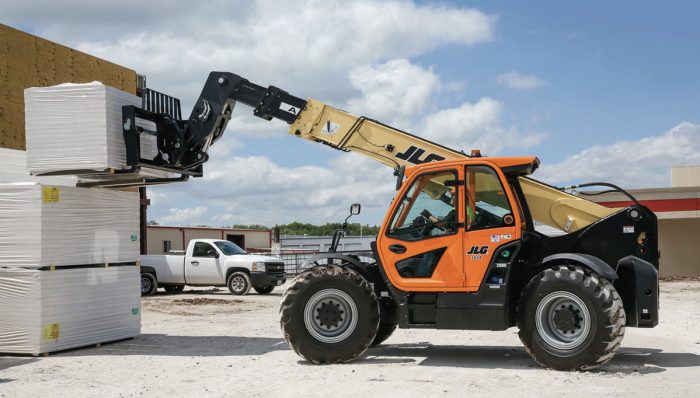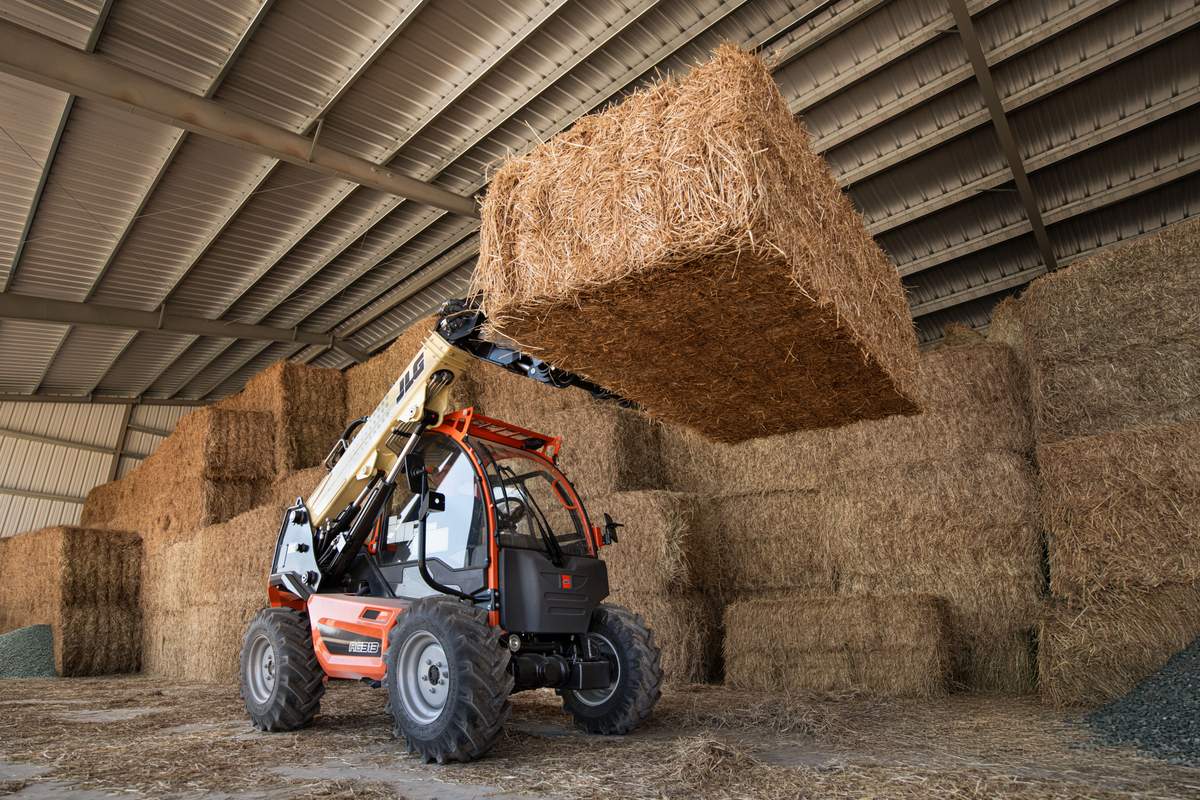Telehandler Trends: Attachments, Telematics and Training Are Lifting Compact Telescopic Carriers to New Heights

Compact telehandlers are proof that bigger isn’t always better. You see, these small, nimble machines can load, lift and place materials all around a jobsite and fit into places larger telehandlers can’t, making them a perfect asset in tight spaces.
“Compact telehandlers have a small footprint yet offer plenty of power to pick up, stack, load, unload, scoop, dump, lift, carry and/or place jobsite materials,” says John Boehme, senior product manager — telehandlers at JLG. “They are right-sized for completing so many different tasks on jobsites, and this flexibility means that compact telehandlers can get a large variety of work done on a project, from the initial phases to the closing stages. For example, one compact telehandler can be used to load and unload trucks and then to move materials from place to place and then again for jobsite cleanup and landscaping.”
Thanks to their smaller size and vast capabilities, compact telehandlers are growing in popularity. Let’s take a look at some trends hitting the compact telehandler market to make these machines even better.
Attachments for Telehandlers

Aside from its size, one of the most appealing features of a compact telehandler is its ability to use attachments — allowing operators to take on a variety of jobs with the machine. Some popular compact telehandler attachments include carriages, forks and buckets. Manufacturers are equipping their machines with features to make attachment taking and usage even easier and more efficient.
“When you’re looking at where the industry is heading with telehandlers, it’s really about maximizing their versatility so they can fit the most jobs possible,” says Amalija Kopac, Genie’s senior product manager. “There are already a number of attachments available for telehandlers, and the number and type of attachments is likely to continue to grow in the future. The important thing with attachments is to make sure that they’re certified for use on the machine you’re using, and that they’re being used properly.”
Kopac goes on to explain that the Genie Quick Attach system expands the company’s telehandler material handling options with the likes of its universal skid steer adapter, which allows operators to pull up and attach to a wide variety of skid steer-type attachments in seconds. Skyjack’s Readyhook, yoke-mounted lifting hook comes standard on the company’s TH Series telehandlers.
“With capacities that match the maximum lift capability of the telehandler, the hook allows the safe under-slinging of loads and avoids the practice of using the forks as an underslung lifting device,” says Malcolm Early, vice president of marketing at Skyjack. “Skyjack’s TH Series telehandlers offer a wide variety of carriages, fork options and additional attachments designed to increase telehandler productivity to help you tackle the ever-changing jobsites.”
JLG’s SmartLoad is an advanced bundle of three integrated technologies that work together to increase operator confidence and optimize productivity. Boehme explains that this award-winning, industry-first system includes automatic attachment recognition, a load management information system and a load stability indicator.

“Select JLG telehandlers are equipped with a load stability indication [LSI] system which can aid operators by helping them to remain within the forward load capacity of the telehandler,” says Boehme. “Also, advancements in backup camera technology, like JLG’s multi-reverse camera system, can help operators see more on the backside of the machine. And, advancements in boom control technology, such as JLG’s remote boom control, enable operators to control the telehandler’s boom from outside the cab.”
Speaking of the machine’s cab, Skyjack’s TH Series telehandlers feature an innovative cab design called Flexcab that allows fleet operators to easily convert between open and enclosed cabs with simple hand tools, providing increased flexibility for fleet movement and fast response to customer demands. Skyjack also took a look at the machine’s controls to increase productivity.
“Skyjack’s telehandlers use Skycoded, a proven and simplistic control system using our color coded and numbered wiring system to make our machines the easiest to troubleshoot,” says Early. “Using a relay-based control system allows Skyjack’s telehandlers to operate with simpler components resulting in less maintenance and lower costs.”
Electrifying Compact Telehandlers

Electrification is a huge trend in the construction equipment industry right now, and it’s making its way into the compact telehandler market.
“Technology is continuously developing, and globally the focus on reducing emissions produced by off-highway construction equipment, including telehandlers, continues to expand exponentially,” says John Boehme, senior product manager of telehandlers at JLG. “One of the current trends in the compact telehandler market is toward owning and operating equipment that comes equipped with the latest hybrid technology, direct drive and/or lithium-ion batteries. Right now, current electrical technology does tend to be more applicable to smaller machines, and there are several electric-drive telehandler models already available in the market.”
Curious what’s currently out there? Three electric compact telehandlers making waves are JCB’s 505-20E, Snorkel’s SR5719E and Manitou’s MT 625e.
Staying Connected
Another trend in compact telehandlers includes connectivity and the ability to monitor your machine’s health and productivity. Today’s manufacturers are dedicated to developing and including these digital offerings with their compact telehandlers.
“The move toward connected jobsites continues to influence the entire construction equipment industry’s focus, including JLG’s, in 2023 and beyond,” says Boehme. “For example, IoT is changing how we develop equipment and how equipment interacts with operators and technicians. By being able to mine meaningful data from these machines throughout the workday, we can help customers improve fleet utilization, maintenance, serviceability and uptime. This data is also extremely valuable for decision-making and planning purposes.”
JLG customers can choose from a full suite of connected products, including the company’s next-generation ClearSky Smart Fleet IoT platform, BIM modeling, an augmented reality app and virtual reality training simulators. Boehme says these innovative, connected technologies help equipment owners and operators monitor and manage their aerial equipment fleets.
Early explains that when developing Skyjack’s Elevate platform, the company worked with its customers to identify and provide the most important data points that solve day-to-day pain points in rental service and management for immediate impact. This feedback helped Skyjack to create its Elevate offering which provides operators with actionable insights to make their businesses more efficient.
“Increased utilization, strategically planned service, precision billing and monitored usage to promote safety, are some of the ways that Elevate delivers real value,” says Early. “Beyond hours and location provided by basic telematics systems, Elevate delivers machine-specific alerts and analysis, which can dramatically reduce unnecessary service calls and trips to the site for diagnostic work.”
Need help managing maintenance schedules? Genie Lift Connect is up to the task. This powerful tool can be accessed through the Genie Lift Connect web portal or through an API in an existing telematics interface, which enables operators to easily manage Genie equipment along with other brands in a mixed fleet. Genie Lift Connect updates data from the equipment every 15 minutes so fleet and service managers can use the information to efficiently use their resources to predict failures or prescribe maintenance based on how the equipment is being used in the field.
“Digitization and telematics are another trend, especially when it comes to maximizing productivity and minimizing the total cost of ownership,” says Kopac. “We are still early in the telematics journey for telehandlers, but there is growing interest from the market in using the data they’re collecting to more effectively manage and maintain their telehandler fleet.”
Emphasis on Training and Safety

Just like any machine, compact telehandlers need skilled operators to reach their full potential on the job. This starts with the right training and certification based on OSHA requirements, as well as ANSI standards.
“Increasing operator confidence and productivity on jobsites continue to drive change across the telehandler market,” says Boehme. “With reference to safety standards for these machines, it is important to know that all telehandlers, including compact models, are covered in the Powered Industrial Truck 1910.178 regulations mandated by OSHA, which requires operators to be trained and certified to operate a telehandler.”
To help meet those requirements, many telehandler OEMs and rental houses offer telehandler training and certification programs. For example, JLG’s AccessReady training program meets all published OSHA and ANSI specifications for proper telehandler training so operators can walk onto the jobsite knowing they have the right credentials. Bonus: Boehme says AccessReady trainers can train operators on both JLG and non-JLG equipment, so they can be successful no matter what.

As for Genie, the manufacturer offers both Lift Pro online operator training, as well as in-person Train-the-Trainer courses. Kopac notes that these opportunities are used to qualify operators in the safe use of MEWPs or telehandlers and then provide additional helpful training techniques and information to improve their ability to deliver successful operator training courses.
Skyjack offers operator and trainer courses on-site or at its head office in Guelph, Ontario, Canada, as well as training kits for experienced trainers to deliver training materials in compliance with MEWP standards CAN/CSA-B354.8:17 and ANSI/SAIA A92.24-2018 and Telehandler standards CSA B335-15 (R2020) and ANSI/ITSDF B56.6-2016. Early points out that Skyjack and IPAF training programs are generic and applicable to all brands of machines. Becoming well versed on the machine and its owner’s manuals and other literature are also important.
“Over the years, there have been tremendous advances in equipment across the board,” Early adds. “This is a very exciting time, but it does also mean that even the most experienced operators could be unfamiliar with a machine. Many common errors in operation and safety practices can be avoided by reading the manual or quick start guides.”
Pam Kleineke is managing editor of Compact Equipment.
Three Compact Telehandlers to Consider

JLG SkyTrak 3013
JLG’s ultra-compact SkyTrak 3013 telehandler is designed to meet the needs of landscapers, do-it-yourself homeowners, small industrial work and agricultural applications. The machine weighs approximately 5,300 lbs with a load capacity of 2,700 lbs and a 13-ft lift height. Its light weight allows for transport on small tow-behind trailers.
Genie GTH-5519
With a compact size and variety of attachments, the Genie GTH-5519 is a versatile, multi-purpose tool on the jobsite. Easy to maneuver and transport with the capacity to lift up to 5,500 lbs, it meets the needs of many construction, masonry, landscape and agricultural applications. Contributing to its maneuverability is four-wheel drive, four-wheel steer and limited slip front axle differential.
Skyjack SJ519TH
Skyjack’s complete TH Series offers capacities from 5,500 to 20,000 lbs, with its SJ519TH being the most popular in terms of compact telehandlers. With a capacity of 5,500 lbs and a maximum lifting height of 19 ft, 1 in., the SJ519TH is designed with all major service points easily accessible, limiting downtime and increasing customer utilization, offering the rental industry a great life cycle value.




